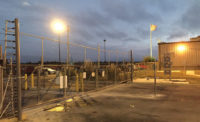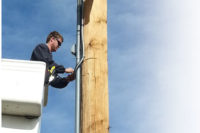Before there were video analytics there were outdoor intrusion detectors — photobeams, motion detectors and the like. These devices still are much in demand: With homeowners and business customers more security-conscious than ever before, outdoor intrusion protection, in fact, is gaining in popularity. Six trends in this field incorporate technology advances that have enhanced the reliability of outdoor intrusion protection, while at the same time making it more economical to implement.
1. WIRELESS OPTIONS REDUCE LABOR
“We’re seeing a lot more wireless perimeter protection,” comments Jen Przewoznik, North American marketing leader for Melville, N.Y.-based security equipment distributor ADI. “The cost of wireless devices is still higher than for wired products, but the difference is shrinking — and because wireless devices require less labor to install, they are becoming an increasingly attractive option. Dealers like the fact that they don’t have to do trenching, for example.”
A sensor that communicates wirelessly with the control panel typically costs about $100 more than its wired equivalent, notes Shawn Benevides, senior product marketing manager for ADI. But dealers often can easily make up the cost difference through reduced labor requirements, Benevides says. Dealers often have labor costs that exceed $100 an hour, and in many cases, eliminating the need to run wires to an outdoor sensor can save at least an hour in labor.
Benevides adds, though, that it’s a good idea to use traditional low-voltage connection to power wireless outdoor devices. Batteries in an outdoor environment tend to require frequent replacement, he says.
Rockville, Md.-based security dealer Robert Lintz has begun to use an outdoor passive infrared detector that Honeywell, Melville, N.Y., introduced a year or two ago to protect garages, sheds and pools. “Previously we would have discouraged people from going that route because of false alarm and installation problems,” Lintz notes.
2. PORTABLE OUTDOOR SYSTEMS
Wireless communication between the control panel and the central station also has created new opportunities involving outdoor intrusion protection.
One company that has devised a creative solution using cellular communication is Armstrong’s Communication — a central station located in Coal Creek, New Brunswick, Canada that provides wholesale alarm monitoring. The company offers its dealer customers a cellular-capable portable alarm system designed to provide outdoor intrusion protection for construction sites or other locations that need protection on a temporary basis.
Another element of the system is a passive infrared detector from Visonic Ltd., Bloomfield, Conn. that was designed especially for outdoor use over a wide temperature range. Northeastern Protection Service, a security dealer based in Dartmouth, Nova Scotia, Canada recently used three of the Armstrong’s systems, with Visonic PIRs hardwired to the control panels, to protect critical infrastructure supporting the Canada Winter Games.
“The units were sitting out in the open and working in sub-zero conditions with snow and rain and we had no false alarms,” describes Roger Miller, vice president of operations for Northeastern Protection Services.
3. VIDEO VERIFICATION ENHANCES ACCURACY OF OUTDOOR SYSTEMS
Manufacturers have made great strides in minimizing the false alarms that previously were a big challenge in outdoor installations. (See the related sidebar below, “How We Tackle False Alarms.") But even with these enhancements, some false alarms may still occur — and recognizing that, some security dealers have begun to take a different approach to outdoor protection. They have begun to install video cameras triggered by intrusion sensors as a means of verifying whether an alarm is caused by a human intruder. Conversely, a dealer that might otherwise have used video alone may add outdoor intrusion detectors to the installation to eliminate the need for guards to continuously watch the cameras.
Dan Tullis, a staff engineer for TNT Solutions, recently advised a utility company that had multiple locations protected by numerous video cameras as well as combination microwave-PIR detectors from Sparks, Nev.-based manufacturer Protection Technologies — but the two technologies were not integrated. By integrating the equipment and using the ProTech devices to automatically display video from cameras located within the dual-technology detector’s view, the utility company will be able to use guards more efficiently and effectively, Tullis describes.
Some video cameras have internal motion detection, but using external motion detectors provides several advantages in comparison with an internal solution, comments Jeffrey Morris, national sales manager for Protection Technologies.
The analytics that drive internal video motion detection have to be continually calibrated — a process that can take a whole season in an outdoor environment, Morris says.
4. NEW TIER OF PROTECTION: ALERTS, NOT ALARMS
Advances in technology have given security dealers new options in terms of what happens when an outdoor sensor is tripped. Some homeowners just want to know when someone enters their yard. They don’t necessarily want the police to be called.
Honeywell had this sort of customer in mind when it introduced its wireless outdoor passive infrared detector, which is often sold in combination with control panels that support Honeywell’s Total Connect service. Total Connect can be tied in with a video camera, enabling homeowners to receive alerts with video clips via a cellphone or other cellular device without generating an alarm at the central station. At press time in early March, Honeywell also was planning to introduce a wireless outdoor contact that could be used, for example, to generate an alert if someone were to open the gate to a backyard pool.
Depending on the circumstances, the homeowner could call a neighbor to check on things or, if appropriate, could call the police.
5. CREATIVE SOLUTIONS FOR COPPER THEFT
Mountain Alarm, an Ogden, Utah-based security dealer, recently came up with a creative solution for a farmer who had experienced theft of copper from a power system he used for his farm machinery.
“We ended up putting in a security system with wireless transmitters and a series of relays to monitor power so that if power was turned off, there would be an alarm,” recalls Bret Anderson, general manager for Mountain Alarm.
Mountain Alarm mounted a weather-proof enclosure to each of the farmer’s power poles. Inside it was a power supply, a relay and a long-range wireless transmitter from DMP, Springfield, Mo. “We feed AC power through the relay and we monitor the relay so if it de-energizes, we will get an alarm.” Each pole also got a siren, which sounds on alarm. Since we did that, they haven’t had a single theft,” Anderson comments.
6. ANIMAL ALERTS
While some outdoor intrusion systems are designed to avoid alarms caused by animals, some people in remote areas such as Alaska have installed systems designed specifically to detect large animals such as deer and moose.
As Benevides explains, these systems are installed along the edge of highways, automatically lighting up warning signs to alert drivers if a large animal is detected.
These systems use hundreds of daisy-chained detectors that are set in about 40 to 50 yards from the road side. The detectors used have two protection beams and are set up so that a large animal will break both beams, Benevides describes.
| Photobeams & Laser Detectors |
|
One of the mainstay technologies of outdoor intrusion protection is the photoelectric beam. Consisting of a paired receiver and transmitter, these devices cover a linear area over a great distance, generating an alarm if the beam is broken. But installing these devices can be time-consuming and sometimes it’s impractical to use them because of obstacles in the coverage area. As a result, some dealers turn to other options, such as passive infrared or microwave detectors — or devices that combine the two technologies. Manufacturers of these devices have made numerous refinements over the years to enhance their false alarm immunity. (See related article, “How We Tackle False Alarms” on page 90.)
Other options for outdoor intrusion protection include active infrared and laser detection technology. Active infrared works in a similar manner to a photoelectric beam, but with multiple beams, explains Jim Quick, president and CEO of Optex America, manufacturer of a wide range of outdoor intrusion detectors. Laser detectors create a curtain of protection when installed in a vertical mode or a horizontal plane of protection when installed in a horizontal mode, Quick says. Optex offers a laser detector that self-maps an area. “If you have trees or vegetation or a storage container, the detection pattern will go around it or it can be manually mapped by putting it in a manual mode,” Quick describes. In the manual mode, “it will watch the installer walk the area that needs to be detected and logs it into memory — or you can plug it into a laptop and use the mouse to scan the area you want detected,” he adds.
Quick says laser detectors increasingly are being used to protect electrical substations, water treatment plants, prisons and other high-security areas as an alternative to photoelectric beams. Criminals, he says, are getting smarter and sometimes crawl under or jump over the photoelectric beam pattern. |
| How We Tackle False Alarms |
|
One of the biggest challenges of outdoor intrusion protection is a greater likelihood of false alarms caused by factors such as weather conditions and animals. Manufacturers of security equipment have made a range of innovations to their intrusion detectors with the goal of minimizing false alarms. As Mark Ingram, president of Visonic’s North American operations explains, most outdoor PIRs have two pyroelectric elements and often each element is divided into four separate beams. The goal is to minimize false alarms by requiring all elements of both beams to trip before an alarm is reported, filtering out many types of false alarms, such as those caused by many types of animals. Ingram says Visonic has refined this concept even further with the outdoor PIR the company introduced about a year ago. The device has eight pyroelectric elements, each split into four separate protection beams — and, as Ingram explains, a sophisticated algorithm is used to determine whether or not the pattern of beams tripped is a human intruder. The device also includes active infrared sensors designed to generate a trouble signal if the device is masked during an unarmed period. Some outdoor intrusion devices combine a PIR with another technology, requiring both to trip before an alarm is reported. Protection Technologies, for example, offers a PIR in combination with a stereo Doppler microwave detector. As Jeffrey Morris, national sales manager for Protection Technologies explains, the microwave detector is designed to detect movement and can be adjusted to look for movements as small as 4 inches or as wide as 40 inches. This approach makes the devices highly immune to false alarms, Morris says, but for an extra level of false alarm immunity, the device will not trigger an alarm unless the PIR also trips. |







